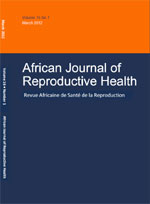
|
African Journal of Reproductive Health
Women's Health and Action Research Centre
ISSN: 1118-4841
Vol. 23, No. 4, 2019, pp. 54-62
|
 Bioline Code: rh19050
Bioline Code: rh19050
Full paper language: English
Document type: Research Article
Document available free of charge
|
|
|
African Journal of Reproductive Health, Vol. 23, No. 4, 2019, pp. 54-62
| fr |
Ajani, Tinuade A; Elikwu, Charles J.; Nwadike, Victor; Babatunde, Tayo; Anaedobe, Chinenye G; Shonekan, Opeoluwa; Okangba, Chika; Oluwasola, Timothy; Omeonu, Azubuike; Faluyi, Bibitayo; Thompson, Tunde E; Ebeigbe, Ejime; Ajani, Mustapha A; Joshua, Amelia K; Kolawole, Titilope; Kristilere, Heritage; Meremikwu, Chibuike M; Mgbemena, Lucky; Nwaejike, Chika S; Salami, Ayodeji; Tantua, Anatorun; Timothy, Mayowa; Akagbusum, Tobenna & Coker, Akintoye Ol
Résumé
L'infection génitale à Chlamydia trachomatis

provoque une morbidité et une mortalité importantes chez les femmes. Un certain
nombre d'études épidémiologiques ont suggéré que la réaction en chaîne par polymérase (RCP) est plus précise en tant qu'outil de
diagnostic pour Chlamydia trachomatis. Cependant, l'utilisation des marqueurs sérologiques peut être rentable et pratique pour
diagnostiquer et estimer la charge de la maladie dans les pays à ressources limitées. Cette étude visait à déterminer les marqueurs
sérologiques (IgG, IgM et IgA) de Chlamydia trachomatis, évaluer l'association entre l'infection à Chlamydia trachomatis et les
caractéristiques sociodémographiques et le diagnostic clinique des participantes. Il s'agissait d'une étude transversale en milieu
hospitalier dans laquelle des échantillons de sang de 145 participantes consentantes ont été testés pour les anticorps IgG, IgM et
IgA contre Chlamydia trachomatis en utilisant un dosage immuno-enzymatique et leur diagnostic clinique, extraits de leurs notes
de cas. La prévalence cumulative de la séropositivité pour Chlamydia trachomatis (IgG, IgM, IgA) était de 112 (77,2%) tandis
que 33 (22,8%) étaient séronégatives. Le séromarqueur prédominant global était l'Ig G 91 (62,8%) tandis que l'Ig M et l'IgA
représentaient respectivement 85 (58,6%) et 54 (37,2%). Une association statistiquement significative a été trouvée entre
l'infection à Chlamydia trachomatis et le PID (valeur p = 0,031), l'infertilité primaire (valeur p 0,011) et le niveau de revenu
(valeur p = (0,045). (Afr J Reprod Health 2019; 23[4]: 54-62).
Mots Clés
Chlamydia trachomatis; marqueurs sérologiques IgG; IgM; IgA; PID
|
| |
| en |
Assessment of Serological Markers of Genital Chlamydia trachomatis  Infection Among the Gynaecology Patients attending Babcock University Teaching Hospital, Ilishan-Remo, Ogun State, Nigeria Infection Among the Gynaecology Patients attending Babcock University Teaching Hospital, Ilishan-Remo, Ogun State, Nigeria
Ajani, Tinuade A; Elikwu, Charles J.; Nwadike, Victor; Babatunde, Tayo; Anaedobe, Chinenye G; Shonekan, Opeoluwa; Okangba, Chika; Oluwasola, Timothy; Omeonu, Azubuike; Faluyi, Bibitayo; Thompson, Tunde E; Ebeigbe, Ejime; Ajani, Mustapha A; Joshua, Amelia K; Kolawole, Titilope; Kristilere, Heritage; Meremikwu, Chibuike M; Mgbemena, Lucky; Nwaejike, Chika S; Salami, Ayodeji; Tantua, Anatorun; Timothy, Mayowa; Akagbusum, Tobenna & Coker, Akintoye Ol
Abstract
Genital Chlamydia trachomatis infection causes significant morbidity and mortality in women. A number of epidemiologic
studies have suggested that Polymerase Chain Reaction (PCR) is more accurate as a diagnostic tool for Chlamydia trachomatis.
However, the use of serological markers may be cost effective and practical in diagnosing and estimating the burden of the
disease in resource limited countries.This study was aimed at determining the serological markers (IgG, IgM and IgA) of
Chlamydia trachomatis, evaluate the association between Chlamydia trachomatis infection and the sociodemographic
characteristics and clinical diagnosis of the participants. This was a cross sectional hospital-based study in which blood samples
from 145 consenting participants were tested for IgG, IgM and IgA antibodies against Chlamydia trachomatis using enzyme
linked immunosorbent assay and their clinical diagnosis, retrieved from their case notes. The cumulative prevalence of
seropositivity for Chlamydia trachomatis (IgG, IgM, IgA) was 112 (77.2%) while 33 (22.8%) were seronegative. The overall
predominant seromarker was IgG 91(62.8%) while IgM and IgA accounted for 85(58.6%) and 54(37.2%) respectively. A
statistically significant association was found between Chlamydia trachomatis infection and PID (p value = 0.031), primary
infertility (p value 0.011) and level of income (p value= (0,045). (Afr J Reprod Health 2019; 23[4]: 54-62).
Keywords
Chlamydia trachomatis; Serological markers IgG; IgM; IgA; PID
|
| |
© Copyright 2019 - African Journal of Reproductive Health
Alternative site location: http://www.ajrh.info
|
|
